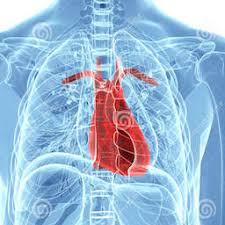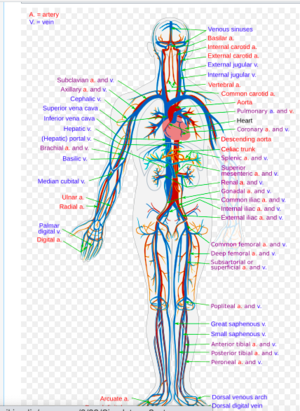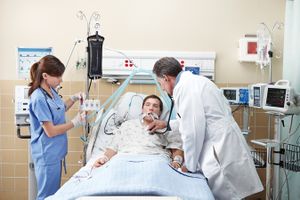Vital Organs: Difference between revisions
No edit summary |
No edit summary |
||
| (13 intermediate revisions by 3 users not shown) | |||
| Line 1: | Line 1: | ||
<div class="editorbox"> | <div class="editorbox"> | ||
'''Original Editor '''- [[User: | '''Original Editor '''- [[User:Lucinda hampton|Lucinda hampton]] | ||
'''Top Contributors''' - {{Special:Contributors/{{FULLPAGENAME}}}} | '''Top Contributors''' - {{Special:Contributors/{{FULLPAGENAME}}}} | ||
</div> | </div> | ||
== Introduction == | == Introduction == | ||
[[File:Heart location.jpg|right|frameless]] | |||
The human body contains five organs that are considered vital for survival. They are the | The human body contains five organs that are considered vital for survival. They are the | ||
* | * [[Anatomy of the Human Heart|Heart]]: located in the center of the chest, and its function is to keep [[Blood Physiology|blood]] flowing through the body. Blood carries substances to cells that they need and also carries away wastes from cells. | ||
* [[Brain Anatomy|Brain]]: located in the head and functions as the body’s control center. It is the seat of all thoughts, [[Memory|memories]], perceptions, and feelings. | |||
* [[Kidney]]: The two kidneys are located in the back of the abdomen on either side of the body. Their function is to filter blood and form [[Urinary Tract Infection|urine]], which is excreted from the body. | |||
* [[Liver Disease|Liver]]: located on the right side of the abdomen. It has many functions, including filtering blood, secreting bile that is needed for digestion, and producing proteins necessary for blood clotting. | |||
* [[Lung Anatomy|Lungs]]: located on either side of the upper chest. Their main function is exchanging oxygen and carbon dioxide with the blood. | |||
If any of the five vital organs stop functioning, the death of the organism is imminent without medical intervention.<ref>Libre Text Vital Organs Available: https://bio.libretexts.org/Bookshelves/Human_Biology/Book%3A_Human_Biology_(Wakim_and_Grewal)/10%3A_Introduction_to_the_Human_Body/10.4%3A_Human_Organs_and_Organ_Systems ( accessed 6.7.2021)</ref> | |||
== | == Organs == | ||
[[File:Circulatory system.png|right|frameless]] | |||
An organ is a self-contained group of tissues that performs a specific function in the body. The body’s organs are grouped into organ systems based on the functions they perform. Humans have 11 different organ systems. | |||
== | # [[Integumentary System|Integumentary]] (skin, hair, nails) | ||
# <span class="sui sui-pencil"></span>Skeletal ([[Bone|bones]]) | |||
# <span class="sui sui-pencil"></span>Muscular ([[Muscle: Smooth|smooth]], cardiac, and [[Muscle Cells (Myocyte)|skeletal muscles]]) | |||
# <span class="sui sui-pencil"></span>[[Cardiovascular System|Circulatory]] (heart, arteries, veins) | |||
# <span class="sui sui-pencil"></span>[[Respiratory Assessment|Respiratory]] (lungs, diaphragm, larynx) | |||
# <span class="sui sui-pencil"></span>Digestive (stomach, intestines, liver) | |||
# <span class="sui sui-pencil"></span>Urinary (kidneys, ureters, bladder) | |||
# <span class="sui sui-pencil"></span>[[Immune System|Immune]] ([[Lymphatic System|lymph]] nodes, [[Bone Marrow|bone marrow]], thymus) | |||
# <span class="sui sui-pencil"></span>[[Introduction to Neuroanatomy|Nervous]] (brain, spinal cord, nerves) | |||
# <span class="sui sui-pencil"></span>[[Metabolic and Endocrine Disorders|Endocrine]] (pituitary gland, thyroid, adrenals) | |||
# <span class="sui sui-pencil"></span>Reproductive (penis, vagina, prostate, uterus)<ref>Biology Dictionary Organs Available: https://biologydictionary.net/organ/ (accessed 6.7.2021)</ref> | |||
<span class="sui sui-pencil"></span> | |||
== Multisystem Organ Failure == | |||
[[File:Intensive Care Unit.jpg|right|frameless]] | |||
Multisystem organ failure is commonly encountered in the [[The Intensive Care Unit|intensive care]] setting, often requiring a multi-disciplinary approach to management. It is increasingly being recognised that organ failures do not exist in isolation, but rather result from and have an impact on the dysfunction of other organs, mediated by haemodynamic, neurohormonal, and [[Cytokines|cell signaling]] feedback mechanisms, an interplay that has been termed organ cross-talk. Common examples of this relationship between organ systems include cardiorenal, hepatorenal, and pulmonary-renal syndromes, each of which has a significant impact on the likelihood of recovery of individual organs and overall prognosis<ref>ICU Multiple Organ Support Available: https://healthmanagement.org/c/icu/issuearticle/introduction-to-multiple-organ-support ( accessed 6.7.2021)</ref> | |||
== References == | == References == | ||
<references /> | <references /> | ||
[[Category:Physiology]] | |||
Latest revision as of 17:31, 18 January 2023
Original Editor - Lucinda hampton
Top Contributors - Lucinda hampton, Uchechukwu Chukwuemeka and Kim Jackson
Introduction[edit | edit source]
The human body contains five organs that are considered vital for survival. They are the
- Heart: located in the center of the chest, and its function is to keep blood flowing through the body. Blood carries substances to cells that they need and also carries away wastes from cells.
- Brain: located in the head and functions as the body’s control center. It is the seat of all thoughts, memories, perceptions, and feelings.
- Kidney: The two kidneys are located in the back of the abdomen on either side of the body. Their function is to filter blood and form urine, which is excreted from the body.
- Liver: located on the right side of the abdomen. It has many functions, including filtering blood, secreting bile that is needed for digestion, and producing proteins necessary for blood clotting.
- Lungs: located on either side of the upper chest. Their main function is exchanging oxygen and carbon dioxide with the blood.
If any of the five vital organs stop functioning, the death of the organism is imminent without medical intervention.[1]
Organs[edit | edit source]
An organ is a self-contained group of tissues that performs a specific function in the body. The body’s organs are grouped into organ systems based on the functions they perform. Humans have 11 different organ systems.
- Integumentary (skin, hair, nails)
- Skeletal (bones)
- Muscular (smooth, cardiac, and skeletal muscles)
- Circulatory (heart, arteries, veins)
- Respiratory (lungs, diaphragm, larynx)
- Digestive (stomach, intestines, liver)
- Urinary (kidneys, ureters, bladder)
- Immune (lymph nodes, bone marrow, thymus)
- Nervous (brain, spinal cord, nerves)
- Endocrine (pituitary gland, thyroid, adrenals)
- Reproductive (penis, vagina, prostate, uterus)[2]
Multisystem Organ Failure[edit | edit source]
Multisystem organ failure is commonly encountered in the intensive care setting, often requiring a multi-disciplinary approach to management. It is increasingly being recognised that organ failures do not exist in isolation, but rather result from and have an impact on the dysfunction of other organs, mediated by haemodynamic, neurohormonal, and cell signaling feedback mechanisms, an interplay that has been termed organ cross-talk. Common examples of this relationship between organ systems include cardiorenal, hepatorenal, and pulmonary-renal syndromes, each of which has a significant impact on the likelihood of recovery of individual organs and overall prognosis[3]
References[edit | edit source]
- ↑ Libre Text Vital Organs Available: https://bio.libretexts.org/Bookshelves/Human_Biology/Book%3A_Human_Biology_(Wakim_and_Grewal)/10%3A_Introduction_to_the_Human_Body/10.4%3A_Human_Organs_and_Organ_Systems ( accessed 6.7.2021)
- ↑ Biology Dictionary Organs Available: https://biologydictionary.net/organ/ (accessed 6.7.2021)
- ↑ ICU Multiple Organ Support Available: https://healthmanagement.org/c/icu/issuearticle/introduction-to-multiple-organ-support ( accessed 6.7.2021)









